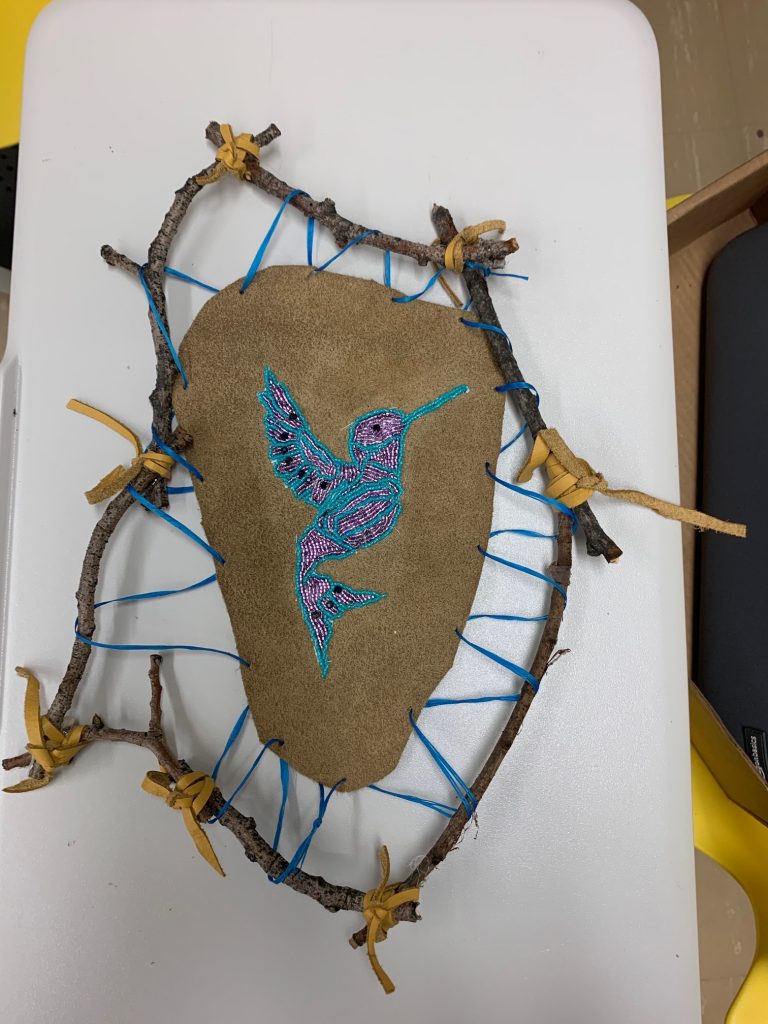For my visual representation of learning, I decided to truly incorporate Indigenous ways of knowing. As a hands-on learner, I know that I need to immerse myself in the culture to further understand and fully appreciate it. In addition, I am actually a tad frightened to teach about reconciliation. Even though I am extremely passionate and love learning about different aspects of Indigenous cultures, I come from a background of colonization. How am I supposed to teach about Indigenous practices if I have never experienced them? That is why I feel it is so important to become involved in the culture. For these reasons, I chose to traditionally bead a hummingbird. Involving myself in the culture is my own way of putting myself in the shoes of an Indigenous person, which will hopefully allow me to be more accepting and empathetic, and help me connect to my students.

When I was brainstorming what to bead to demonstrate my learning, I really wanted to do something nature-related to represent the importance of the land in Indigenous cultures. The flowers and landscapes I was envisioning had little connection to my own life and seemed like a superficial, cliche symbol. After a lot of consideration, I finally decided on the hummingbird. The hummingbird is an important part of my life. My grandma, who passed away in 2015, absolutely adored them. Since her passing, I have started to notice them everywhere and I feel as if they are a message from her. Although this bird is important to me for personal reasons, I acknowledged that there must be a different perspective and way of knowing. After doing some research, I found that “In Native American culture, hummingbirds are seen as healers and bringers of love, good luck and joy” (What Does a Hummingbird, n.d). This actually reinforced my feelings of being connected to my grandma; always bringing me love. Because I chose this bird I am able to tie in my own grief and healing, and at the same time create new meaning for myself. To my future students, I can be the bringer of love.
The hummingbird was not the only aspect of this piece that I chose deliberately. I carefully chose the colours to emphasize the elements of reconciliation that I would like to focus on as an educator. The colour turquoise represents healing and protection. After learning from many stories, including the powerful stories in Muffins for Granny, I quickly recognized that there is a great amount of healing that needs to occur. At the same time, we need to work on protecting and promoting the culture that is still present. I believe that my beading is a small way to keep the culture present in my own learning. Similarly, I chose purple because it is associated with sacredness and spirituality; two characteristics that are meaningful in Indigenous cultures. I hope that my classroom will be a safe, sacred space for of my students. The purple, however, also represents my own privilege. Purple is often associated with royalty and the aristocracy. As a person with white privilege, I wanted to acknowledge that so I can continue to move forward and away from systemic racism. To me, this is an incredibly important part of reconciliation; acknowledging my privilege and realizing a change needs to be made.
Throughout the duration of this course, I have realized just how critical borders are in the classroom (Pirbhai-Illich, 2019). I did not comprehend just how I restricted I was in all of my classrooms. As a stereotypical western colonizer, I did not realize the extent to which colonization affected our classrooms. It is my hope that I can set up my classroom so that it is not an example of colonization. This directly relates to my piece as hummingbirds are not affected by borders. They are able to freely move wherever to accommodate their needs. I hope my students feel the same way in my classroom.